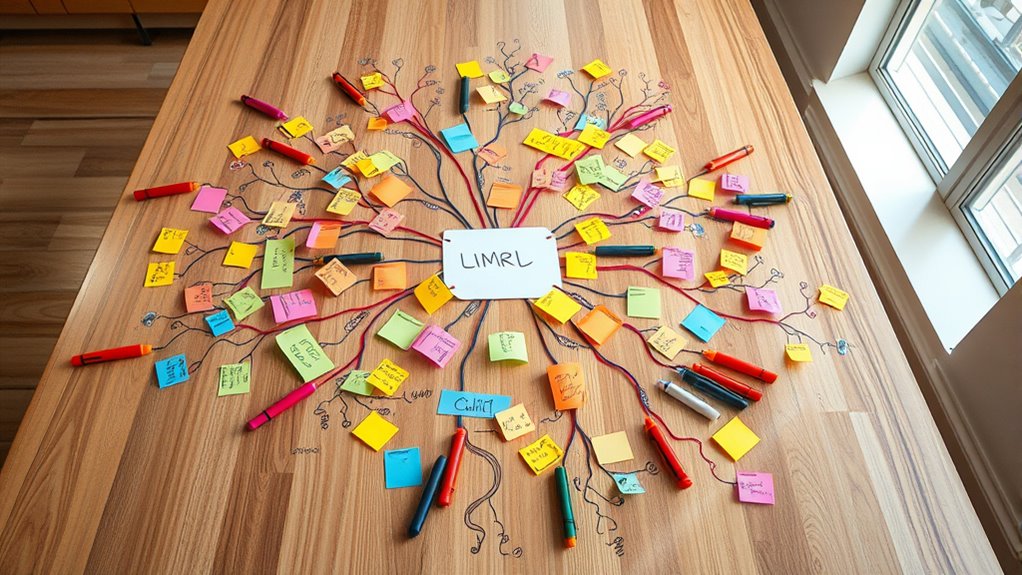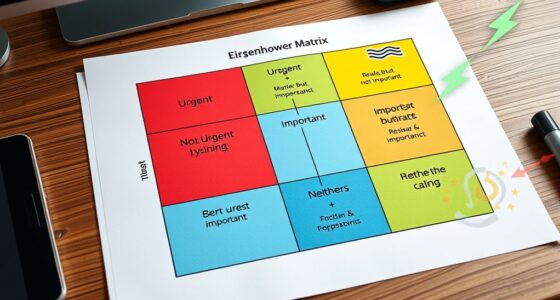To boost your non-linear thinking with mind maps, focus on keeping your ideas flow organic and colorful. Start with a central concept and let ideas branch out spontaneously, using images and symbols to make connections clear. Use vibrant colors to differentiate topics and rearrange branches as your thoughts evolve. This flexible approach helps you see relationships and patterns, sparking creativity. Continue exploring these tricks to discover even more ways to harness your natural thinking style.
Key Takeaways
- Use spontaneous, free-flowing branches that expand organically without strict hierarchies.
- Incorporate vibrant colors and symbols to differentiate ideas and enhance visual clarity.
- Place the central idea prominently and allow thoughts to radiate outward naturally.
- Add, rearrange, or expand branches flexibly to reflect evolving thoughts and connections.
- Focus on visual cues and patterns to identify new insights and foster creative associations.

Ever wonder how some people effortlessly organize their ideas and boost their creativity? The secret often lies in mastering the art of mind mapping. For non-linear thinkers like you, traditional note-taking can feel restrictive, making it hard to see the bigger picture or connect ideas logically. That’s where visual organization becomes your best friend. Mind maps allow you to lay out concepts in a free-flowing, colorful web, giving you a visual overview that’s both engaging and intuitive. Instead of forcing ideas into rigid lines or lists, you can let your thoughts flow naturally from one idea to another, creating a dynamic landscape of your creative brainstorming. This approach taps into your natural tendency to think in images and associations, making it easier to generate new ideas and see relationships you might otherwise miss.
Unlock your creativity with colorful, free-flowing mind maps that connect ideas visually and intuitively.
When you start a mind map, you’re not just jotting down ideas—you’re creating a visual blueprint of your thought process. Use vibrant colors, images, and symbols to differentiate branches, making your mind map visually appealing and easy to navigate. This visual organization helps you quickly identify main themes and subtopics, fostering a clearer understanding of how different ideas connect. As you expand your map, you can add branches spontaneously, which supports your creative brainstorming by encouraging free association without the constraints of linear structure. This flexibility keeps your mind open to new possibilities and helps you break free from traditional thinking patterns.
Another trick is to start with a central idea or problem in the middle of your page, then branch out into related concepts. Don’t worry about order or hierarchy at first; just let your thoughts flow outward. You can always rearrange or add new branches later. The key is to keep the flow organic, which aligns with how non-linear thinkers process information. This method not only sparks creativity but also enhances your ability to see connections between disparate ideas. Over time, you’ll notice patterns emerging, leading to innovative solutions or fresh perspectives you might have overlooked with more linear methods.
Using visual organization in your mind maps makes creative brainstorming more engaging and less intimidating. It transforms abstract ideas into tangible visuals, making complex topics easier to grasp and explore. Additionally, understanding the importance of a high contrast ratio can help you optimize your visual setup for clearer thinking and better focus. As you become more comfortable with this technique, you’ll find it easier to develop and refine your ideas, solve problems creatively, and communicate your thoughts more effectively. Ultimately, mastering these mind mapping tricks empowers you to harness your unique way of thinking, turning your natural creativity into a powerful tool for generating insights and achieving your goals.
Frequently Asked Questions
Can Mind Mapping Improve Memory Retention?
Yes, mind mapping can improve your memory retention. By creating visual diagrams, you strengthen your visual memory and make it easier to recall information. It helps you organize complex ideas clearly, making connections between concepts more apparent. As you visualize and structure information visually, your brain retains it better, leading to enhanced understanding and long-term memory. This active approach boosts your ability to remember details more efficiently and effectively.
What Tools Are Best for Digital Mind Mapping?
When choosing the best tools for digital mind mapping, you should look for cloud-based options that let you access your maps anywhere. Visual diagramming features are essential, so pick tools that offer intuitive drag-and-drop interfaces and customizable templates. Popular choices include MindMeister, Coggle, and Miro, which excel at creating clear, engaging diagrams. These tools help you organize your ideas efficiently, especially if you’re a non-linear thinker.
How Long Does It Take to Master Mind Mapping?
Mastering mind mapping can feel like opening the secrets of the universe! The learning curve varies, but with consistent practice, you’ll see remarkable skill development in just a few weeks. Dedicate even 15-30 minutes daily, and you’ll become proficient faster than you think. Remember, it’s not about perfection but progress—so stay committed, and soon, mind mapping will be your superpower!
Is Mind Mapping Suitable for Team Collaboration?
You’ll find mind mapping highly suitable for team collaboration, as it promotes clear visual communication. Using collaborative techniques, everyone can contribute ideas simultaneously, enhancing team dynamics. It encourages open discussion and helps organize complex information effectively. By engaging all members, mind mapping fosters a shared understanding and boosts creativity. Overall, it’s a dynamic tool that strengthens teamwork and streamlines project planning, making it a valuable asset for collaborative efforts.
Can Mind Mapping Help With Creative Brainstorming?
Imagine revealing a secret weapon for your idea generation sessions. Mind mapping acts as a visual organization tool that sparks creativity and helps you explore ideas freely. It encourages non-linear thinking, making brainstorming more dynamic and engaging. By laying out concepts visually, you can see connections you might miss otherwise, turning a simple session into a powerful creative process that transforms scattered thoughts into innovative solutions.
Conclusion
Think of your mind as a wild, sprawling forest. Mind mapping is your trusty compass, guiding you through tangled branches and hidden clearings. With these tricks, you’ll navigate effortlessly, uncovering new paths and ideas you hadn’t seen before. Embrace the journey, and remember, even the densest woods can lead to beautiful, unexpected vistas. Trust your map, stay curious, and watch your non-linear thinking blossom into a vibrant, thriving landscape.









